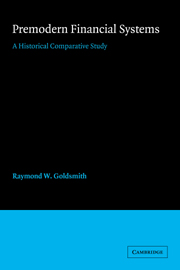Book contents
- Frontmatter
- Contents
- List of tables
- Preface
- 1 Introduction
- 2 The financial systems of the ancient Near East
- 3 The financial system of Periclean Athens
- 4 The financial system of Augustan Rome
- 5 The financial system of the early Abbasid caliphate
- 6 The financial system of the Ottoman Empire at the death of Suleiman I
- 7 The financial system of Mughal India at the death of Akbar
- 8 The financial system of early Tokugawa Japan
- 9 The financial system of Medici Florence
- 10 The financial system of Elizabethan England
- 11 The financial system of the United Provinces at the Peace of Münster
- 12 Similarities and differences
- Notes
- Bibliography
- Index
7 - The financial system of Mughal India at the death of Akbar
Published online by Cambridge University Press: 05 March 2012
- Frontmatter
- Contents
- List of tables
- Preface
- 1 Introduction
- 2 The financial systems of the ancient Near East
- 3 The financial system of Periclean Athens
- 4 The financial system of Augustan Rome
- 5 The financial system of the early Abbasid caliphate
- 6 The financial system of the Ottoman Empire at the death of Suleiman I
- 7 The financial system of Mughal India at the death of Akbar
- 8 The financial system of early Tokugawa Japan
- 9 The financial system of Medici Florence
- 10 The financial system of Elizabethan England
- 11 The financial system of the United Provinces at the Peace of Münster
- 12 Similarities and differences
- Notes
- Bibliography
- Index
Summary
At the death of Akbar “the Great” in a.d. 1605 Mughal India with a population of about 110 million and an area of about 2.5 million km2, covering the entire peninsula down to about 19° North, contained about one-fifth of the population of the world, was only one-fourth below that of Ming China, and was slightly ahead of the total of the several dozen states into which Europe was then divided. This was a dramatic change from the situation at the accession of Akbar in 1556 when his domain was limited to about 0.3 million km2 and probably had no more than 30 million inhabitants. The empire, enlarged as the result of about half a century's warfare, had become unified in some important respects – pax Akbarica, a common monetary system, free movement throughout the empire, and a basically similar system of taxation and land allocation – but it still showed many regional differences in the details of political and financial arrangements.
Although the size of the empire somewhat increased during the seventeenth century under Akbar's three successors (Jahangir, Shahjehan, and Aurangzeb, particularly in the Dekkan) and while urbanization, real national product per head, internal and particularly foreign trade increased, and the financial system developed, the empire at the death of Akbar was probably at the peak of its political power and coherence and close to its economic zenith.
- Type
- Chapter
- Information
- Premodern Financial SystemsA Historical Comparative Study, pp. 94 - 122Publisher: Cambridge University PressPrint publication year: 1987

